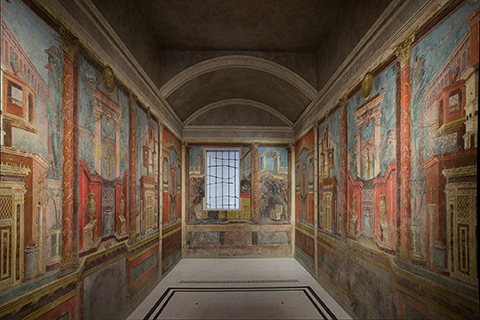 1>
1>Invented reconstructions of ancient stage sets inevitably drew the in-house wall-paintings into a tautological relationship with the stage scenery that they were supposedly derived from. Since ancient scenography no longer existed the temptation to use Second Style wall-paintings to reconstruct ancient stage scenery proved irresistible. These modern reconstructions by default became the de facto proof that ancient wall-painting did indeed depict stage scenery. The inevitable result of this tautological relationship was that the wall-paintings, now deemed to be copies of stage sets, ceased to posses symbolic value and consequently were not considered worthy of semantic or semiological investigation. Associating the paintings with the ancient stage denied them an intrinsic value, other than that of ‘spectacle’, which further prompted historians such as Paul Zanker and Eleanor Leach to use them as evidence of nouveau riche conspicuous consumption and self-fashioning, all of which further decontextualised their iconic value. For more on this theme see my chapter House as Palace. More recent computer visualisations of Second Style wall-paintings, such as those produced by the King's College 3D Visualisation Lab, have thankfully resisted the temptation to use them to produce invented stage sets. Preferring instead to selectively reproduce in 3-dimensions only those wall-paintings that are considered to be most stage-like.
Apart from the visual evidence, the theoretical basis for making a direct link between ancient domestic wall-painting and stage scenery is exclusively derived from ambiguous and therefore much disputed Latin texts in Book 5.6.9 and 7.5.2 of Vitruvius’s De Architectura (On Architecture or The Ten Books on Architecture, thought to have been written around 20BC). The impetus for drawing heavily on this text was ignited by the discovery, at the turn of the last century, of wall-paintings in cubiculum M in Villa P. Fannius Synistor at Boscoreale, near Pompeii (fig.1&2). The room's significance lay in the fact that it appeared to confirm Vitruvius's observation, made in Book 7.5.2, that tragic, comic and satyric themes were subjects depicted in domestically located wall-paintings. This seemingly innocuous observation was further complicated by the fact that he used similar Latin words in Book 5.6.9 to describe stage-scenery painted in the tragic, comic and satyric style. Despite the ambiguity associated with these texts they became the textual proof that stage-scenery was reproduced in domestically located wall-painting. This issue will be discussed in detail later in this chapter in The discovery of Villa P. Fannius Synistor and the scaenarum frontes - scaenae frons conundrum.
|